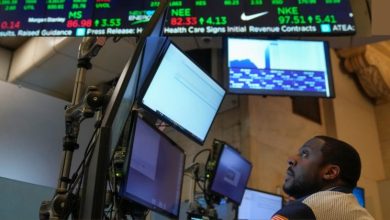10 Predictive Signs a Recession Will Hit America Before 2026

Wall Street and Main Street are sending multiple, concurrent warnings that increase the likelihood of a U.S. recession before 2026. Accelerating corporate layoffs and automation-driven payroll cuts, rising consumer-credit distress and repossessions, recent contagious bankruptcies and bank write-offs, cooling corporate profits and capex, weakening labor-market breadth, deteriorating financial conditions, surging safe‑haven flows such as gold, and offbeat indicators (cardboard-box orders, discretionary Halloween sales, underwear replacement patterns, lipstick demand) together raise the odds that localized stress could cascade into a national downturn. Below are 10 specific signals to watch.
- Corporate retrenchment and big-tech layoffs — Major employers shifting from growth to cost discipline signal weaker future payrolls and consumer demand. Amazon’s planned cut of up to 30,000 corporate roles and continued reductions across tech and finance reduce direct income for high‑wage workers and ripple through local services and vendors. Large, concentrated layoffs also undermine hiring momentum: firms that trimmed headcount in one cycle often pause new hiring and slow contractor spend, cutting demand for consulting, advertising and commercial real estate. Watch severance durations, rehiring rates and whether layoffs move beyond discretionary and hiring-slow sectors into consumer‑facing retail and logistics — that progression typically marks an escalation from corporate belt‑tightening to broader demand contraction.
- Consumer‑credit stress and auto distress (rising delinquencies and repossessions) — Spiking auto delinquencies and the recent surge in repossessions are a concrete, high‑frequency signal of household strain, especially in transit‑dependent areas. When subprime auto defaults rise, they reduce consumer spending directly (lost mobility) and indirectly (weaker credit scores, reduced access to loans). Elevated delinquencies also force banks and nonbank lenders to tighten underwriting, elevating borrowing costs and shrinking available credit. Monitor 30‑ and 60‑day delinquency rates, repossession volumes, subprime originations and losses at nonbank lenders — rapid deterioration there often precedes cuts in retail and services spending.
- Contagion from bankruptcies and bank write‑offs (e.g., First Brands, Tricolor) — Idiosyncratic defaults can become systemic if they expose concentrated exposures in private credit, CLOs or regional banks. The First Brands and Tricolor collapses highlighted valuation blind spots and prompted write‑offs that forced some institutions to re-evaluate risk models. If underwriters tighten or funds face redemptions, credit supply to mid‑market firms and consumer lenders can dry up, raising funding costs and triggering investment and payroll cuts. Track bank charge‑offs, CLO tranche performance, and redemption activity at private‑credit funds for signs of contagion.
- Regional divergence and state‑level weakness (contraction in key states) — National aggregates can mask concentrated weakness; state‑level downturns in industrial, agricultural or federal‑dependent regions can pull down national GDP if they hit large economies. Analyses showing a third of U.S. GDP in slowing states matter because supply chains and financial linkages transmit local shocks. Watch payroll and unemployment trends, port and manufacturing activity, and state tax receipts in California, New York, Texas, and Midwestern manufacturing states — coordinated weakness across these hubs often presages national recession.
5. Cooling corporate profits and reduced capital expenditures (capex) — When leading firms report slowing top‑line growth and cut capital programs, demand for machinery, software and construction falls. Reduced capex not only dampens near‑term GDP but also signals managements’ lower confidence in future demand. Pay attention to guidance changes, order backlogs, and inventories in industrial sectors as early indicators; declines in supplier revenue (semiconductors, industrial equipment) often precede broader investment pullbacks.
6. Automation, AI adoption and labor‑market dislocation — Broad deployment of AI and automation can lift productivity while reducing payroll needs, particularly for white‑collar and administrative roles. This dynamic can produce a “good news” productivity spike but a “bad news” labor income shortage if displaced workers take long to reskill. Monitor job openings by occupation, wage growth divergence across sectors, and corporate announcements tying job cuts to automation to assess whether productivity gains translate to durable unemployment pressure.
7. Tightening financial conditions and yield‑curve signals (flattening/inversion, wider corporate spreads) — A persistent inversion of short‑ and long‑term yields and widening corporate spreads raise borrowing costs and reduce the viability of leveraged investments. These moves compress refinancing windows for firms and uplift debt servicing risks, especially for lower‑grade borrowers. Watch the 3‑month/10‑year and 2‑year/10‑year spreads, corporate‑bond spread levels, and issuance volumes — sustained stress there historically precedes recessions.
8. Weakening labor‑market breadth (slowing hiring, longer job transitions) — Aggregate unemployment can lag underlying weakness. Broader metrics — the employment‑population ratio, labor-force participation, involuntary part‑time work and median tenure — often deteriorate before the headline jobless rate rises. Track the Sahm rule threshold, weekly unemployment claims, and sectoral hiring data (leisure, retail, manufacturing) for early signs that the labor market’s resilience is eroding.
9. Sentiment shifts and safe‑haven flows (surging gold and falling confidence) — Rapid inflows to safe havens like gold (up more than 50% in 2025) and widening gaps between consumer sentiment and real activity suggest that investors and households are pricing higher tail risk. When sentiment deteriorates, consumption and capex slow as both consumers and businesses delay purchases. Monitor household confidence indices, money‑market flows into treasuries and gold, and FX‑adjusted dollar moves to gauge risk sentiment intensity.
10. Offbeat, granular indicators worth watching (cardboard boxes, discretionary seasonal sales, underwear and lipstick patterns) — High‑frequency, unconventional signals often preview broader trends: falls in cardboard orders signal reduced goods shipping and inventory building ahead of holiday seasons; weak demand for discretionary seasonal items (e.g., Home Depot’s giant skeletons) can indicate tightening household budgets; underwear‑replacement and “little treat” purchases reflect shifts in consumer priorities. These noisy indicators are not definitive alone but, when aligned with formal data, strengthen the case for a pending downturn.
Why it matters: the simultaneous deterioration across these ten areas — credit, corporate behavior, regional activity, labor breadth, financial conditions and even safe‑haven demand — raises the odds that localized stress could cascade into a nationwide recession before 2026. Monitor payrolls, delinquency data, earnings guidance, yield‑curve spreads and state‑level GDP releases for confirmation.




